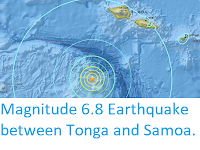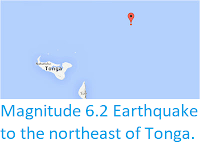The Tonga Meteorological Service has issued a warning to aviation following an eruption on Metis Shoal, a submarine volcano between the islands of Koa and Late, on Tuesday 15 October 2019. The volcano began erupting at about 8.30 am local time, producing a column of ash between 4500 and 5000 m high. Volcanic ash is extremely hazardous to aircraft in a number of ways. At
its most obvious it is opaque, both visually and to radar. Then it is
abrasive, ash particles physically scour aircraft, damaging components
and frosting windows. However the ash is most dangerous when it is
sucked into jet engines, here the high temperatures can melt the tiny
silica particles, forming volcanic glass which then clogs engine. When
this happens the only hope the aircraft has is to dive sharply, in the
hope that cold air passing through the engine during the descent will
cause the glass to shatter, allowing the engine to be restarted.
Obviously this is a procedure that pilots try to avoid having to
perform.
An ash column over Metis Shoal, Tonga, on 15 October 2019. Samuela Folaumoetu'i/Real Tonga Airlines.
Metis Shoal is a growing submarine volcano which is (most of the time) slightly below the sea surface. However it has been producing small dome islands following eruptions since at least the 1780s, and while these have, to date, all washed away afterwards, it is likely that one day the volcano will grow into a true volcanic island.
(Top) An exposed island in Metis Shoal in December 2006. Royal New Zealand Air Force/Institute of Geological & Nuclear Sciences/Smithsonian Global Volcanism Program. (Bottom) Waves breaking over the shoal in February 1968, showing the position of an island that appeared in December 1967 then eroded away. Charles Lundquist/Smithsonian Astrophysical Observatory/Smithsonian Global Volcanism Program.
The islands of Tonga lie along the boundary between the Pacific and
Australian Tectonic Plates. The Pacific Plate is being subducted beneath
the Australian Plate along the Tonga Trench, which forms the boundary
between these two plates, with the volcanic islands that make up the
archipelago being formed as the subducting plate is melted by the heat
of the planet's interior, so that lighter minerals rise up through the
overlying plate as liquid magma, which fuels the volcanoes that build
the islands.
Diagram showing subduction along the Tonga Trench, and how this feeds the volcanoes of the Tonga Volcanic Arc. York University.
See also...
Follow Sciency Thoughts on Facebook.










